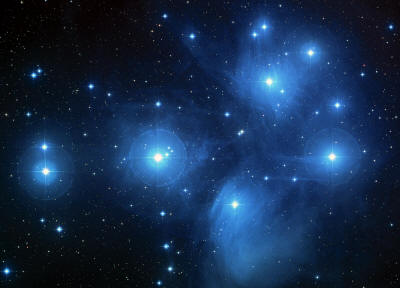|

from
Wikipedia Website
Las Pléyades (que significa "palomas" en griego), también conocidas
como Objeto Messier 45, Messier 45, M45, Las Siete Hermanas o
Cabrillas, es un objeto visible a simple vista en el cielo nocturno
con un prominente lugar en la mitología antigua, situado a un
costado de la constelación Tauro.
Las Pléyades son un puñado de
estrellas muy jóvenes las cuales se sitúan a una distancia
aproximada de 450 años luz de la Tierra y están contenidas en un
espacio de treinta años luz.
Se formaron aproximadamente hace apenas
unos 100 millones de años, durante la era Mesozoica en la Tierra, a
partir del colapso de una nube de gas interestelar.
Las estrellas
más grandes y brillantes del cúmulo son de color blanco-azulado y
cerca de cinco veces más grandes que el Sol.
Pléyades
Distancia
La distancia al cúmulo ha sido estimada por muchos métodos, pues es
un paso importante en la calibración de las distancias en el
universo. El conocimiento exacto de la distancia de las Pléyades le
permite a los astrónomos trazar un diagrama de Hertzsprung-Russell,
para estimar la distancia a otros cúmulos desconocidos.
Otros
métodos pueden entonces extender la escala de distancia, de cúmulos
abiertos a galaxias y posteriormente a cúmulos de galaxias,
permitiendo construir una escala cósmica de distancias.
Los resultados anteriores al lanzamiento del satélite Hipparcos
encontraron que las Pléyades estaban aproximadamente a unos 135
parsec (440 años luz) de la Tierra. Hipparcos causó consternación
entre los astrónomos al encontrar una distancia de solamente 118
parsec (384,7 años luz) midiendo el paralaje de algunas estrellas
del cúmulo, una técnica que debe de indicar los resultados más
directos y exactos. Trabajos más recientes han encontrado que la
distancia calculada por Hipparcos era errónea, si bien se desconoce
la causa de este error.
La distancia específica de las Pléyades
todavía se desconoce, pero actualmente se piensa que la verdadera
distancia es mayor que 135 parsec.
Composición
El cúmulo tiene unos 12 años luz de diámetro y
contiene un total aproximado de 500 estrellas.
Está dominada por
estrellas azules jóvenes, de las cuales 8 pueden ser observadas a
simple vista dependiendo de las condiciones atmosféricas (cielos muy
limpios y ausencia de Luna): Taygeta, Pleione, Merope, Maia,
Electra, Celaeno, Atlas y Alcyone
El orden de sus estrellas más brillantes es parecido al de la Osa
Mayor y Osa Menor, con una masa total estimada en unas 800 masas
solares.
El cúmulo está compuesto en una buena parte por enanas marrones —objetos
con menos del 8% de la masa solar, los cuales son demasiado livianos
para ser estrellas. Puede que estos objetos constituyan
aproximadamente el 25% de la población total del cúmulo, a pesar de
que sólo contribuyan al 2% su masa total. También, presentes en el
cúmulo están las enanas blancas, las cuales contradicen la posible
edad del cúmulo.
Debido a la corta edad del cúmulo, no se espera que
las estrellas normales puedan haber evolucionado para convertirse en
enanas blancas. Se cree que en vez de ser estrellas individuales de
poca o mediana masa, los progenitores de estas estrellas eran
masivas y orbitaban en sistemas binarios. Durante su rápida
evolución, la transferencia de masa de la estrella más masiva a su
acompañante, pudo haber acelerado su evolución hacia una enana
blanca.
Las cámaras CCD sirven de ellas para calibrar estas.
Otros
Las Pléyades son una prominente vista invernal del
hemisferio norte, y conocidas desde la antigüedad.
Son mencionadas
en varias escrituras antiguas entre las que se encuentran
-
el Mahabharata (Libro 13: Anusasana Parva: Seccion: LXXXVI) en donde se
refieren a ellas como krittikas (sánscrito, que se puede traducir
como "cortadores", quienes criaron a Kartikeya)
-
la Ilíada y la
Odisea de Homero
-
son mencionadas tres veces en la Biblia
-
también son mencionadas en el
Popol Vuh (el libro sagrado de los
Mayas) bajo el nombre de MOTZ que significa "monton" y que según
lo relata dicho libro se originaron cuando "Zipacna el soberbio"
mató a 400 guerreros, cuyas almas fueron tomadas por "Gucumatz el
Gran Corazón del Cielo" y puestas como estrellas en el espacio,
creando así Las Pleyades
Las Pléyades no existían cuando Venus emergió de la nebulosa
protosolar hace 4.500 millones de años.
El 4 de marzo de 1769, Charles Messier las incluyó como el No. 45 en
su primera lista de nebulosas y cúmulos de estrella, que fue
publicada en 1771.
Se ha calculado que las Pléyades tienen un futuro de solamente otros
250 millones de años (Kenneth Glyn Jones); para ese entonces, habrán
sido separadas como estrellas individuales (o múltiples) a lo largo
de su trayectoria.
Bajo condiciones ideales de observación, se pueden apreciar algunas
huellas de nebulosidad, y esto se demuestra en fotografías de larga
exposición. Es una nebulosa de reflexión, causada por polvo que
refleja la luz azul de las estrellas calientes y jóvenes.
Se piensa a menudo que este polvo fue lo que sobró de la formación
del cúmulo, pero con una edad cerca a los 100 millones de años, la
cuál es generalmente la más aceptada para este cúmulo, casi todo el
polvo originalmente presente habría sido dispersado por la presión
de la radiación. Al parecer, el cúmulo está pasando por una región
particularmente polvorienta del medio interestelar.
Los estudios demuestran que el polvo responsable de la nebulosidad
no está distribuido uniformemente, pero que se concentra
principalmente en dos capas a lo largo de la parte que vemos del
cúmulo. Estas capas se pudieron haber formado por la desaceleración
debido a la presión de la radiación a medida que el polvo se ha ido
moviendo hacia las estrellas.
Las principales estrellas son, ordenadas por magnitud:
-
Alcyone
- 2,87
-
Atlas - 3,63
-
Electra
- 3,7
-
Maia - 3,87
-
Merope - 4,18
-
Taygete
-
4,3
-
Pleione
- 5,09 (var.)
-
Celaeno
- 5,46
-
Asterope
- 5,76 -
6,43
|
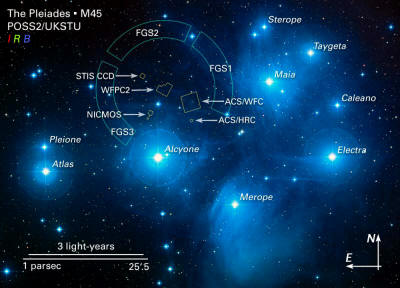 |
Los Mayas
Los Mayas basaron su calendario sagrado
Tzolkin,
en el ciclo de las Pléyades, y creyeron que eran el lugar de origen
de su cultura, eran llamadas Tzab-ek o cola de Serpiente de Cascabel,
y también las conocían como Las Siete Hermanas.
Pleiades
from
Wikipedia Website
The Pleiades, also known as M45, the
Seven Sisters, Seven Stars, SED, Matariki (New Zealand), or Subaru
(Japan), is an open cluster in the constellation of Taurus.
It is
among the nearest star clusters, and is probably the best known, and
is certainly the most obvious to the naked eye. It is sometimes
referred to as the Maia Nebula, perhaps erroneously considering that
the reflection nebulosity surrounding Maia is intrinsic.
The cluster is dominated by hot blue stars which have formed within
the last 100 million years. Dust that forms a faint reflection
nebulosity around the brightest stars was thought at first to be
left over from the formation of the cluster, but is now known to be
an unrelated dust cloud that the stars are currently passing
through.
Astronomers estimate that the cluster
will survive for about another 250 million years, after which it
will have dispersed due to gravitational interactions with its
galactic neighborhood.
Pleiades
Observational history
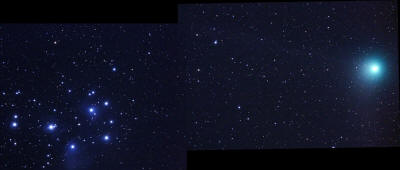
Comet Machholz passes
near the Pleiades in early 2005
The Pleiades are a prominent sight in
winter in the Northern Hemisphere and in summer in the Southern
Hemisphere, and have been known since antiquity to cultures all
around the world, including the Māori and Australian Aborigines, the
Chinese, the Maya (who called them Tzab-ek), the Aztec and the Sioux
of North America.
Some Greek astronomers considered them to be a
distinct constellation, and they are mentioned by Hesiod, and in
Homer's Iliad and Odyssey.
They are also mentioned three times in
the Bible (Job 9:9, 38:31; Amos 5:8).
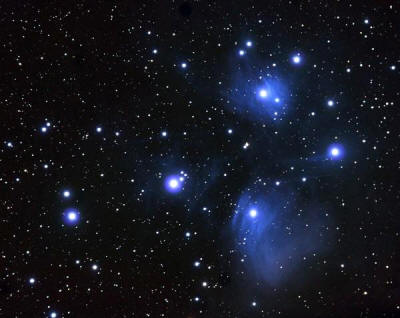
A shorter exposure
shows less nebulosity.
The Pleiades (Krittika) are particularly
revered in Hindu mythology as the six mothers of the war god Skanda,
who developed six faces, one for each of them. Some scholars of
Islam suggested that the Pleiades (At-thuraiya) are the Star in Najm
which is mentioned in the Quran.
They have long been known
to be a physically related group of stars rather than any chance
alignment.
The Reverend John Michell calculated in 1767 that the
probability of a chance alignment of so many bright stars was only 1
in 500,000, and so correctly surmised that the Pleiades and many
other clusters of stars must be physically related. When studies
were first made of the stars' proper motions, it was found that they
are all moving in the same direction across the sky, at the same
rate, further demonstrating that they were related.
Charles Messier measured the position of the cluster and included it
as M45 in his catalogue of comet-like objects, published in 1771.
Along with the Orion Nebula and the Praesepe cluster, Messier's
inclusion of the Pleiades has been noted as curious, as most of
Messier's objects were much fainter and more easily confused with
comets—something which seems scarcely possible for the Pleiades.
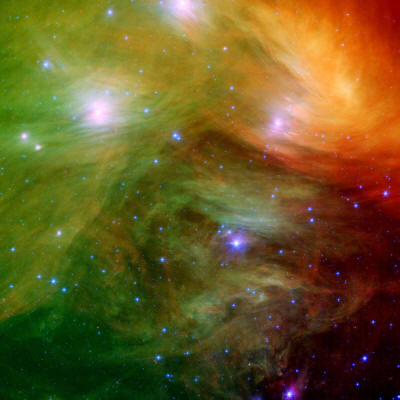
A Spitzer image of
the Pleiades in infrared light, showing the associated dust.
Credit:
NASA/JPL-Caltech
One possibility is that Messier simply
wanted to have a larger catalogue than his scientific rival Lacaille,
whose 1755 catalogue contained 42 objects, and so he added some
bright, well-known objects to boost his list.[5]
Distance
The distance to the Pleiades is an important first step in the
so-called cosmic distance ladder, a sequence of distance scales for
the whole universe. The size of this first step calibrates the whole
ladder, and the scale of this first step has been estimated by many
methods. As the cluster is so close to the Earth, its distance is
relatively easy to measure.
Accurate knowledge of the distance
allows astronomers to plot a Hertzsprung-Russell diagram for
the cluster which, when compared to those plotted for clusters whose
distance is not known, allows their distances to be estimated. Other
methods can then extend the distance scale from open clusters to
galaxies and clusters of galaxies, and a cosmic distance ladder can
be constructed. Ultimately astronomers' understanding of the age and
future evolution of the universe is influenced by their knowledge of
the distance to the Pleiades.
Results prior to the launch of the Hipparcos satellite
generally found that the Pleiades were about 135 parsecs away from
Earth.
Hipparcos caused consternation among
astronomers by finding a distance of only 118 parsecs by measuring
the parallax of stars in the cluster—a technique which should yield
the most direct and accurate results. Later work has consistently
found that the Hipparcos distance measurement for the Pleiades was
in error, but it is not yet known why the error occurred.[6]
The distance to the Pleiades is
currently thought to be the higher value of about 135 parsecs
(roughly 440 light years).
Composition
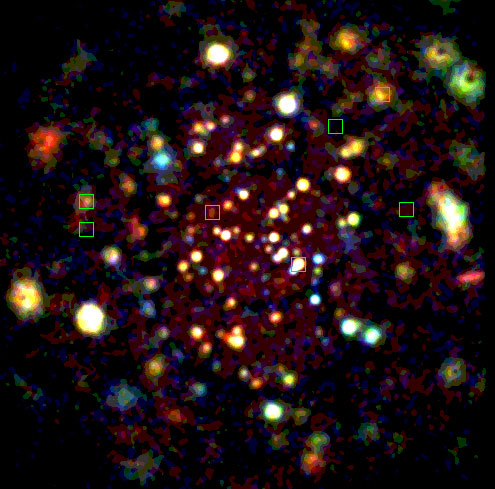
X-ray images of the
Pleiades reveal the stars with the hottest atmospheres.
Green squares
indicate the seven optically brightest stars.
The cluster core radius is about 8
light-years and tidal radius is about 43 light years. The cluster
contains over 1000 statistically confirmed members, although this
figure excludes unresolved binary stars.
It is dominated by young, hot blue
stars, up to 14 of which can be seen with the naked eye depending on
local observing conditions. The arrangement of the brightest stars
is somewhat similar to Ursa Major and Ursa Minor. The total mass
contained in the cluster is estimated to be about 800 solar masses.
The cluster contains many brown dwarfs, which are objects with less
than about 8% of the Sun's mass, not heavy enough for nuclear fusion
reactions to start in their cores and become proper stars.
They may constitute up to 25% of the
total population of the cluster, although they contribute less than
2% of the total mass. Astronomers have made great efforts to find
and analyze brown dwarfs in the Pleiades and other young clusters,
because they are still relatively bright and observable, while brown
dwarfs in older clusters have faded and are much more difficult to
study.
Also present in the cluster are several white dwarfs. Given the
young age of the cluster normal stars are not expected to have had
time to evolve into white dwarfs, a process which normally takes
several billion years. It is believed that, rather than being
individual low- to intermediate-mass stars, the progenitors of the
white dwarfs must have been high-mass stars in binary systems.
Transfer of mass from the higher-mass
star to its companion during its rapid evolution would result in a
much quicker route to the formation of a white dwarf, although the
details of this supposed transfer from a deeper gravity well to a
lesser are unexplained.
Age and future
evolution
Ages for star clusters can be estimated by comparing the Hertzsprung-Russell
diagram for the cluster with theoretical models of stellar
evolution, and using this technique, ages for the Pleiades of
between 75 and 150 million years have been estimated.
The spread in estimated ages is a result
of uncertainties in stellar evolution models. In particular, models
including a phenomenon known as convective overshoot, in which a
convective zone within a star penetrates an otherwise non-convective
zone, result in higher apparent ages.
Another way of estimating the age of the cluster is by looking at
the lowest-mass objects. In normal main sequence stars, lithium is
rapidly destroyed in nuclear fusion reactions, but brown dwarfs can
retain their lithium. Due to lithium's very low ignition temperature
of 2.5 million kelvins, the highest-mass brown dwarfs will burn it
eventually, and so determining the highest mass of brown dwarfs
still containing lithium in the cluster can give an idea of its age.
Applying this technique to the Pleiades gives an age of about 115
million years.
The cluster's relative motion will eventually lead it to be located,
as seen from Earth many millennia in the future, passing below the
feet of what is currently the constellation of Orion. Also, like
most open clusters, the Pleiades will not stay gravitationally bound
forever, as some component stars will be ejected after close
encounters and others will be stripped by tidal gravitational
fields.
Calculations suggest that the cluster
will take about 250 million years to disperse, with gravitational
interactions with giant molecular clouds and the spiral arms of the
galaxy also hastening its demise.
Reflection nebulosity

Hubble Space
Telescope image of reflection nebulosity near Merope
Under ideal observing conditions, some
hint of nebulosity may be seen around the cluster, and this shows up
in long-exposure photographs. It is a reflection nebula, caused by
dust reflecting the blue light of the hot, young stars.
It was formerly thought that the dust was left over from the
formation of the cluster, but at the age of about 100 million years
generally accepted for the cluster, almost all the dust originally
present would have been dispersed by radiation pressure. Instead, it
seems that the cluster is simply passing through a particularly
dusty region of the interstellar medium.
Studies show that the dust responsible for the nebulosity is not
uniformly distributed, but is concentrated mainly in two layers
along the line of sight to the cluster.
These layers may have been formed by
deceleration due to radiation pressure as the dust has moved towards
the stars.
Names and technical
information

A map of the Pleiades
The nine brightest stars of the Pleiades
are named for the Seven Sisters of Greek mythology: Sterope, Merope,
Electra, Maia, Taygete, Celaeno and Alcyone, along with their
parents Atlas and Pleione.
As daughters of Atlas, the Hyades were
sisters of the Pleiades. The English name of the cluster itself is
of Greek origin, though of uncertain etymology. Suggested
derivations include: from πλεîν plein, to sail, making the Pleiades
the "sailing ones"; from pleos, full or many; or from
peleiades,
flock of doves.
The following table gives details of the
brightest stars in the cluster:
Pleiades Bright Stars
|
Name |
Pronunciation (IPA
&
respelling) |
Designation |
Apparent magnitude |
Stellar classification |
|
Alcyone |
/ælˈsaɪəni/,
al-sye'-ə-nee |
Eta (25) Tauri |
2.86 |
B7IIIe |
|
Atlas |
/ˈætləs/,
at'-ləs |
27 Tauri |
3.62 |
B8III |
|
Electra |
/iːˈlɛktrə/,
ee-lek'-trə |
17 Tauri |
3.70 |
B6IIIe |
|
Maia |
/ˈmeɪə, ˈmaɪə/;
may'-ə, mye'-ə |
20 Tauri |
3.86 |
B7III |
|
Merope |
/ˈmɛrəpi/,
mair'-ə-pee |
23 Tauri |
4.17 |
B6IVev |
|
Taygeta |
/teɪˈɪʤətə/,
tay-ij'-ə-tə |
19 Tauri |
4.29 |
B6V |
|
Pleione |
/ˈplaɪəni/,
plye'-ə-nee |
28 (BU) Tauri |
5.09
(var.) |
B8IVep |
|
Celaeno |
/sɪˈliːnoʊ/,
sə-lee'-no |
16 Tauri |
5.44 |
B7IV |
|
Asterope |
/əˈstɛrəpi/,
ə-stair'-ə-pee |
21 and 22 Tauri |
5.64;6.41 |
B8Ve/B9V |
|
— |
— |
18 Tauri |
5.65 |
B8V |
In folklore and literature
“Δέδυκε μεν ἀ σελάννα
καὶ Πληΐαδες, μέσαι δὲ
νύκτες πάρα δ᾽ ἔρχετ᾽ ὤρα,
ἔγω δὲ μόνα κατεύδω.
The Moon is set,
And the Pleiades.
Night's half gone,
Time's passing.
I sleep alone now. ”
— Sappho
“ Which maketh Arcturus, Orion, and Pleiades, and the
chambers of the south.”
— Job 9:9
“ Can you bind the
beautiful Pleiades? Can you loose the cords of Orion? ”
— Job 38:31
“ Slave of the wheel of labor, what to him Are Plato and the
swing of Pleiades? ”
— Edwin Markham, The
Man With the Hoe
“ Many a night I saw the Pleiads, rising thro' the mellow
shade, Glitter like a swarm of fireflies tangled in a silver
braid. ”
— Alfred Tennyson,
Locksley Hall
“ Can I get two maybe even three of these, Comin' from a
space to teach you of the Pleiades. ”
— Red Hot Chili
Peppers, "Can't Stop"
“ Though all I knew of a rote universe were those Pleiades
loosed in December, I promised you I'd set them to verse so
I'd always remember. ”
— Joanna Newsom,
"Emily"
“ Last night I saw the Pleiades again,
Faint as a drift of steam
From some tall chimney-stack; ”
— Arthur Adams, "The
Pleiades"
The Pleiades' high visibility in the
night sky has guaranteed it a special place in many cultures, both
ancient and modern. In Greek mythology, they represented the Seven
Sisters, while to the Vikings, they were Freyja's hens, and their
name in many old European languages compares them to a hen with
chicks.
To the Bronze Age people of Europe, such as the Celts (and probably
considerably earlier), the Pleiades were associated with mourning
and with funerals, since at that time in history, on the
cross-quarter day between the autumn equinox and the winter solstice
(see Samhain, also Halloween or All Souls Day), which was a festival
devoted to the remembrance of the dead, the cluster rose in the
eastern sky as the sun's light faded in the evening.
It was from this acronychal rising that
the Pleiades became associated with tears and mourning. As a result
of precession over the centuries, the Pleiades no longer marked the
festival, but the association has nevertheless persisted, and
accounts for the significance of the Pleiades astrologically.
The early Monte Alto Culture and others in Guatemala such as
Ujuxte and Takalik Abaj, made its early observatories, using the
Pleiades and Eta Draconis as reference, they were called the seven
sisters, and thought to be their original land.
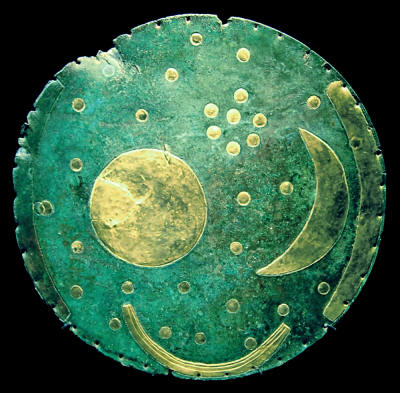
A bronze disk, 1600 BC, from Nebra,
Germany, is one of the oldest known representations of the cosmos.
The Pleiades are top
right.
Heliacal risings very often mark
important calendar points for ancient peoples.
The heliacal rising of the Pleiades
(around June) also begins the new year for the Māori of New Zealand,
who call the Pleiades Matariki. There is an analogous holiday
in Hawai'i known as Makali'i.
The ancient Aztecs of Mexico
and Central America based their calendar upon the Pleiades. Their calendric year began when priests
first remarked the asterism rising heliacally in the east,
immediately before the sun's dawn light obliterated the view of the
stars.
Aztecs called the Pleiades
Tianquiztli (meaning "marketplace").
Indigenous Australians and Mainland Asians
Depending on the tribe or clan, there
are several stories regarding the origins of the Pleiades. Some
Indigenous Australian peoples believed the Pleiades was a woman who
had been nearly raped by Kidili, the man in the moon.
Another version, often painted by Gabriella Possum Nungurayyi as
this is her dreaming (or creation story), daughter of the late
Clifford Possum Tjapaltjarri from the Central desert art movement of
Papunya, depicts the story of seven Napaltjarri sisters being chased
by a man named Jilbi Tjakamarra. He tried to practice love magic to
one of the sisters but the sister did not want to be with him and
with her sisters, they ran away from him.
They sat down at Uluru to search for
honey ants but when they saw Jilbi, they went to Kurlunyalimpa and
with the spirits of Uluru, transformed into stars. Jilbi transforms
himself into what is commonly known as the Morning Star in Orion's
belt, thus continuing to chase the seven sisters across the sky.
Among the Ban Raji, who live in semi-nomadic settlements scattered
throughout western Nepal and northern India, the Pleiades are called
the "Seven sisters-in-law and one brother-in-law" (Hatai halyou daa
salla). Ban Rajis note that when the Pleiades rises up over the
mountain each night, they feel happy to see their ancient kin
(Fortier 2008:in press).
On a more practical note, Ban Rajis can
tell that evening has arrived, indicating that it is about eight
o’clock by local time standards when their star-kin rise above the
Nepali mountains bordering the Kali River.
Native Americans
The Lakota Tribe of North America had a
legend that linked the origin of the Pleiades to Devils Tower.
According to the Seris (of northwestern Mexico), these stars are
seven women who are giving birth. The constellation is known as
Cmaamc, which is apparently an archaic plural of the noun cmaam
"woman".
It was common among the indigenous peoples of the Americas to
measure keenness of vision by the number of stars the viewer could
see in the Pleiades, a practice which was also used in historical
Europe, especially in Greece.
The Native American tribe, the Kiowa, had a myth similar to the
Lakota that explained the creation of the Pleiades. According to the
Kiowa there were seven young maidens that went out to play and were
spotted by several giant bears. The bears saw the young women and
began to chase them. In an effort to escape the bears the women
climbed on top of a rock and prayed to the spirit of the rock to
save them.
Hearing their prayers the rock began to
rise from the ground towards the Heavens so that the bears couldn't
reach the maidens. The seven women reached the sky and were then
turned into the star constellation we know today. The bears in an
effort to climb the rock left deep claw marks in the sides which had
become too steep to climb.
The rock later became known as Devil's
Tower which is located in the state of Wyoming.
In the ancient Andes, the Pleiades were associated with abundance,
because they return to the Southern Hemisphere sky each year at
harvest-time. In Quechua they are called collca', or storehouse.
Paul Goble, Native American storyteller, tells a Blackfoot legend
that he says is told by other tribes as well. In the story, the
Pleiades are orphans that were not cared for by the people, so they
became stars. Sun Man is angered by the mistreatment of the children
and punishes the people with a drought, until the dogs, the only
friends of the orphans, intercede on behalf of the people.
The American
Hopi Indians built their underground
Kivas for multiple
utilitarian uses. The most important of which was their ceremonial
meeting place. The access was a ladder through a small hole in the
roof of the round hole in the ground. During certain ceremonies, the
night passage of the Pleiades over the center of the opening of the
entrance hole was a direct signal to begin a certain ceremony.
Most of the cultures used the angle of
the Pleiades in the night sky as a time telling device.
Ukrainian
In Ukrainian traditional folklore the Pleiades are known as Стожари
(Stozhary), Волосожари (Volosozhary), or Баби-Звізди (Baby-Zvizdy).
'Stozhary' can be etymologically traced to "стожарня" (stozharnya)
meaning a 'granary', 'storehouse for hay and crops', or can also be
reduced to the root "сто-жар", (sto-zhar) meaning 'hundredfold
glowing'.
'Volosozhary' (the ones whose hair is glowing), or 'Baby-Zvizdy'
(female-stars) refer to the female tribal deities. Accordingly to
the legend, seven maids lived long ago. They used to dance the
traditional round dances and sing the glorious songs to honor the
gods. After their death the gods turned them into water nymphs, and,
having taken them to the Heavens, settled them upon the seven stars,
where they dance their round dances (symbolic for moving the time)
to this day. (see article in Ukrainian Wikipedia)
In Ukraine this asterism was considered a female talisman until
recent times.
Other cultures
The Subaru logo depicts the six stars of the Pleiades cluster
that are usually visible from earth with the unaided eye (however it
is possible to see many more than six stars under favorable
conditions).
-
In the Bible the Pleiades supposedly
mentioned as Khima (Amos 5:8); Talmud (Berachot 58B) says that
it has about 100 stars.

-
In Japan, the Pleiades are known as
昴 Subaru, and have given their name to the car manufacturer
whose logo incorporates six stars to represent the five smaller
companies that merged into one. Subaru Telescope, located in
Mauna Kea Observatory on Hawaii, is named after the Pleiades
also.
-
In Arabic the Pleiades are known as
al-Thurayya الثريا, and mentioned in Islamic literature. The
name was borrowed into Turkish as a female name, and is in use
in both Turkey (as Surayya) and Arab countries (for example
Thoraya Obaid). It is also the name of the Thuraya satellite
phone system based in the United Arab Emirates.
-
In Turkish they are known as
Ülker.
-
In the Persian language they are
known as "Pervin".
-
In Chinese constellations, they are
昴 mao, the Hairy Head of the white tiger of the West, while the
name of the Hindu God Kartikeya means him of the Pleiades.
-
In the Swahili language of East
Africa they are called "kilimia" (Proto-Bantu *ki-dimida in
Bantu areas E, F, G, J, L, and S) which comes from the verb
-lima meaning "dig" or "cultivate" as their visibility was taken
as a sign to prepare digging as the onset of the rain was near.
-
In the closely related Sesotho
language of the Southern Africa's Basotho people the Pleiades
are called "Seleme se setshehadi" ("the female planter"). Its
disappearance in April (the 10th month) and the appearance of
the star Achernar signals the beginning of the cold season. Like
many other Southern African cultures, Basotho associate its
visibility with agriculture and plenty.
-
In Western astrology they represent
coping with sorrow and were considered a single one of the
medieval fixed stars. As such, they are associated with quartz
and fennel.
-
In Indian astrology the Pleiades
were known as the asterism (nakshatra) K'ttikā (which in
Sanskrit is translated as "the cutters.") The
Pleiades are called the star of fire, and their ruling deity is
the Vedic god Agni, the god of the sacred fire. It is one of the
most prominent of the nakshatras, and is associated with anger
and stubbornness.
The word has acquired a meaning of
"multitude", inspiring the name of the French literary movement
La Pléiade and an earlier group of Alexandrian poets, the Alexandrian Pleiad.
|

